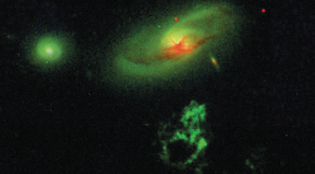 loading
loading
FindingsBurnt-out lightbulb WIYN/ William Keel/Anna ManningView full image
In 2006, Dutch schoolteacher Hanny van Arkel joined Galaxy Zoo, an international citizen science project that helps astronomers classify galaxies in telescopic images. She quickly encountered an object (at bottom in photo; colors are due to filters) so bizarre it baffled the scientists. Four years later, a team led by Kevin Schawinski, a Yale astronomer and Zoo cofounder, has explained Hanny’s Voorwerp in Astrophysical Journal Letters. (Voorwerp is Dutch for “object.”) The Voorwerp is a cloud of gas lit by a quasar—the brightest type of object in the universe—that once shone at the center of the spiral galaxy in the photo. The quasar died, but its light, still traveling through the Voorwerp, makes the gas look “like a bank of fog illuminated by a spotlight,” says Schawinski. In the first-ever measurement of a quasar’s shutdown, the team showed that this one, the nearest quasar to Earth, died in a cosmic instant: less than 70,000 years.
The comment period has expired.
|
|